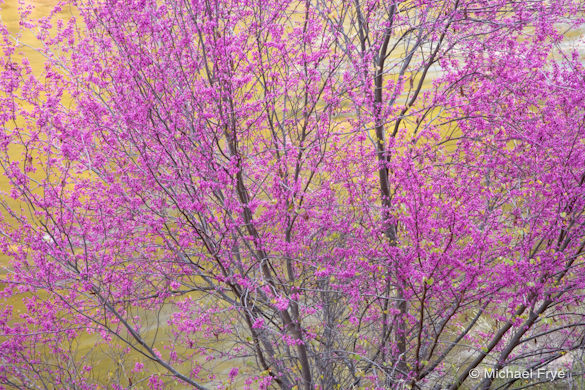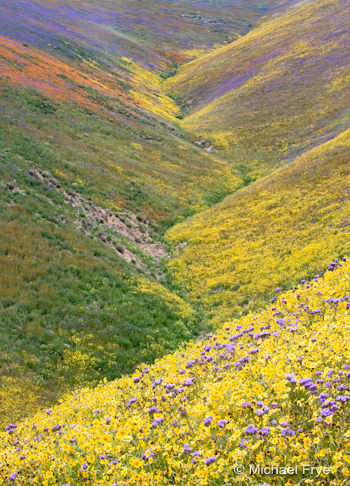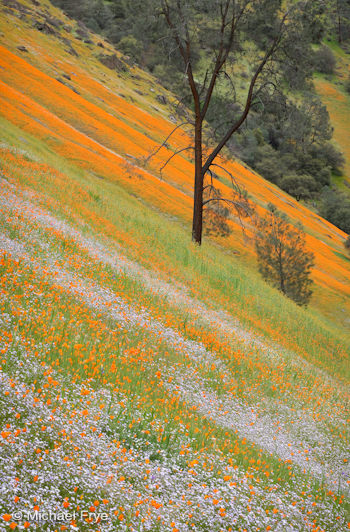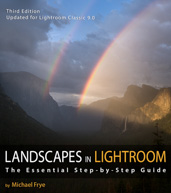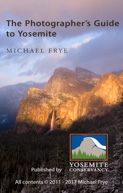Yosemite Photo Conditions
by Michael Frye | Mar 28, 2010 | Yosemite Photo Conditions
Redbud and reflection along the Merced River
Yesterday I drove to and from Yosemite Valley in the dark, but even car headlights were enough to reveal that the redbud are blooming. I’d guess that about half are in full bloom, and the rest should be soon. They’re most photogenic when they just start flowering and before they begin to leaf out—right now for many of them.
March has been dry and warm, but that’s about to change, as a strong and cold storm is expected to reach us Tuesday or Wednesday, with snow levels predicted to reach down to 2500 feet for lower. That cold weather probably won’t affect the redbud much, but might dampen the wildflower bloom in other parts of the state.
by Michael Frye | Mar 20, 2010 | Yosemite Photo Conditions
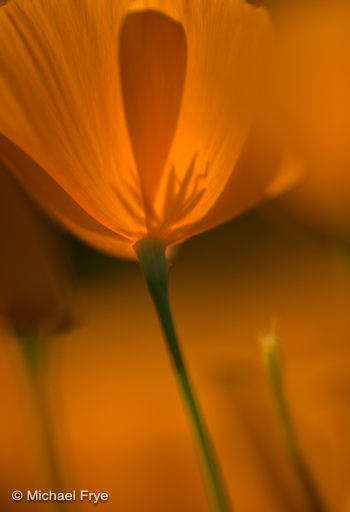
On the way up to Yosemite Valley yesterday my wife and I scouted the flowers in the Merced River Canyon. After a week of warm weather I expected to see more poppies, but they were blooming in the same places, in about the same quantities, as last Sunday. In fact it looked like the hills were starting to dry out, and the poppy season is nearing its end.
We hiked the first half-mile of the Hite’s Cove trail, and found nice mixes of poppies and tri-colored gilia. We ran into several photographers we know—surprise, surprise—and I made some photographs, mostly close-ups of backlit poppies.
While I’m spoiled after last year’s spectacular bloom, this year is below average even by normal standards. I didn’t really believe the map that I linked to in my post from March 9th, which showed below-average precipitation in the Merced River Canyon, since all the surrounding areas are above average. But maybe it’s true.
Elsewhere things are heating up, with reports of flowers coming in from the hills around the southern end of the San Joaquin Valley and near the Carizzo Plain, although Anza-Borrego is apparently disappointing. See that post from March 9th for some links to these reports. Keep in mind that what looks like a great bloom to one person may appear ho-hum to another, and a great variety of flowers does not necessarily mean thick enough carpets for landscape photographs. Personally I’m most interested in dense blooms that have a mix of different colors—rare events, to be sure.
by Michael Frye | Mar 15, 2010 | Yosemite Photo Conditions
My wife and I made a quick trip into the Merced River Canyon yesterday afternoon. We saw some dense but small patches of goldfields, and poppies beginning to emerge. The best poppy location right now is probably the beginning of the Hite’s Cove trail. The areas that burned in the summer of 2008 have some poppies as well, but so far not nearly as many as last year. This week is predicted to be warm and dry, so I would expect that more poppies and other flowers will emerge. It’s unlikely that the display will be as amazing as 2009, but it could still be good. On the other hand, the poppies may be confused by the intermittent wet weather we’ve seen over the past few weeks and never amount to much. I’ll keep you posted.
by Michael Frye | Mar 9, 2010 | Yosemite Photo Conditions
Wildflowers in Carrizo Plain National Monument, April 2006
This could be a great wildflower year in some parts of California, so although I’m on vacation this week I thought I’d pass along some resources, places you can go to find out where the flowers are blooming.
First there’s this map from NOAA depicting rainfall in the western U.S. since September. Note that Death Valley and other areas of the Mojave Desert have received over 150 percent of normal rainfall, so we can expect good flower displays in those areas. Other traditional wildflower hotspots like Anza-Borrego, Antelope Valley, and the Carrizo Plain have also received above-average precipitation.
Carol Leigh has created two great resources for flower photographers: Carol Leigh’s California Wildflower Hotsheet, and the CalPhoto group on Yahoo. Both feature reader reports of wildflowers from around the state. I’ve been a Calphoto member for a long time and it’s a great place to find information about photographing many California subjects, not just wildflowers.
DesertUSA is another valuable site, with wildflower reports for Arizona, Nevada, New Mexico, and Texas as well as California. Also check out the Theodore Payne Foundation’s Wildflower Hotline.
These links just scratch the surface of what’s available, so if you know of other good sources please feel free to post them in the comments.
Of course I’ll keep you up to date on what’s happening around the Yosemite area in this blog. Right now it’s hard to say what kind of wildflower year it will be in the Merced River Canyon west of Yosemite. We’ve had above-average precipitation, but we need a stretch of warm, clear weather to get the bloom rolling.
As a reminder, I won’t be posting a critique this week, so I’ll post the next critique on March 16th or 17th. See you then!
by Michael Frye | Mar 1, 2010 | Photography Tips, Yosemite Photo Conditions
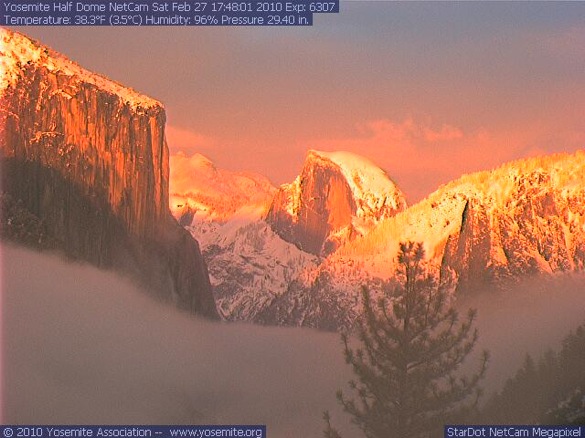
Yosemite Association’s web cam, Saturday, 5:48 p.m.
As I was worked in my office in Mariposa Saturday afternoon I kept an eye on the weather outside, as well as the satellite and radar images on the web, just in case the storm might clear before sunset. It looked like there was a chance, but only a small chance. I had a lot of work to do. I decided to stay home rather than make the two-hour round trip to Yosemite Valley.
Just before sunset I noticed a sliver of clear sky to the west, then sun hitting some trees on a nearby ridge. I looked at the Yosemite Association’s web cam and saw the image you see above. Ouch! Oh well, I guess you can’t always be in the right place at the right time. The moral of the story is that I should always take the chance, even if the odds are low, because it’s precisely those situations when truly spectacular light can occur. I hope some of you were there and captured some great images!
To console myself, my wife Claudia and I drove down to Merced yesterday afternoon to check out the orchards. We found numerous trees in bloom, mostly almonds I think, including this grove where the recent rain had knocked off many petals, making it look like snow had fallen. What appears to be dry ground between the rows of trees is actually long pools of water two to six inches deep covered in blossoms.
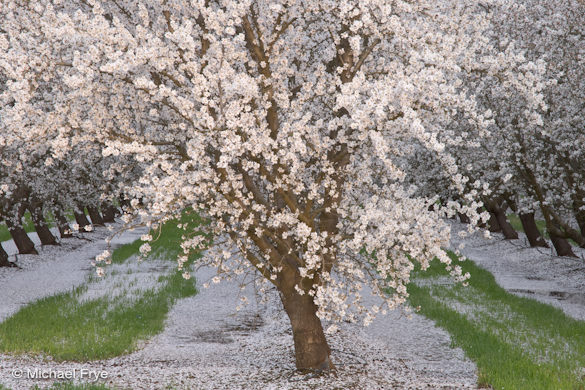
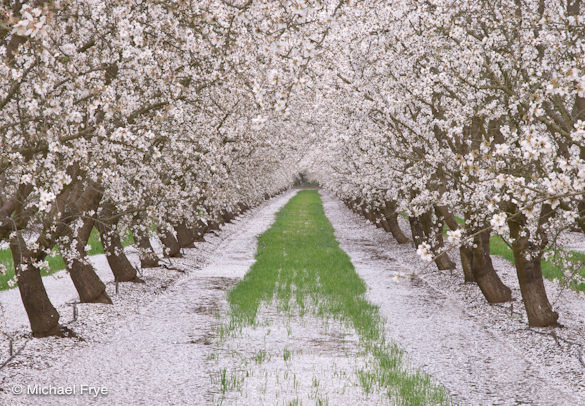
by Michael Frye | Feb 21, 2010 | Yosemite Photo Conditions
Poppies, tri-colored gilia, and a gray pine, March 2009
After a long dry stretch we’ve encountered some wet weather. Rain fell yesterday, and a more significant storm arrived today. This one is cold enough to produce snow in Yosemite Valley. The storm is predicted to end tomorrow morning, and whenever a system like this breaks there’s a chance of seeing classic Yosemite clearing storm conditions. The forecast calls for “unsettled” weather the rest of the week.
A reliable source—namely my frequent workshop assistant Mike Osborne—told me that some poppies, along with a few other flowers, have started to bloom in the Merced River Canyon west of Yosemite. Last year, of course, was a fabulous year for poppies, the best I’ve seen in over 25 years. While it’s unlikely that this year will be as spectacular, we could still have an above-average season since last year’s poppies must have left a lot of seeds, and the ash deposited by the Telegraph Fire of 2008 may still provide left-over benefits. On the other hand, the grass is already quite high and may crowd out the flowers.
I just returned from the NANPA (North American Nature Photography Association) Summit in Reno, Nevada. We heard some great speakers—for example, check out Wild Wonders of Europe, the amazing project co-founded by Friday morning’s keynote speaker, Staffan Widstrand of Sweden.
But the best part of the conference was simply connecting with other photographers. Gary Crabbe told me the astounding story of his freakish accident last year. He literally fell off a forty-foot cliff in the dark. Jed Manwaring entertained us with tales of assisting high-powered advertising photographer Jim Sugar. I traded books with Brenda Tharp and Stephen Ingram, exchanging my new book, Digital Landscape Photography, for an advance copy of the revised edition of Brenda’s (deservedly) popular Creative Nature & Outdoor Photography, and Stephen’s beautiful Cacti, Agaves, and Yuccas of California and Nevada.
But aside from the camaraderie and book trades, I learned a lot. I think we sometimes underestimate the vast knowledge of our fellow photographers. They’re the ones who can get beyond the theories and tell us their practical experiences with equipment and locations. Fellow professionals can help us avoid book contract pitfalls or hassles with permits at a national park. I learned a lot from discussions with other pros about voice-recognition software, something I’ve been trying lately. (If you’re interested in this topic, here’s a great video blog about it.)
Gordon Illg and I had an interesting discussion about why we go to the NANPA Summit. He told me that at his first Summit he had all these plans for meeting editors and photo buyers and showing them his portfolio. Then after a couple of years he stopped trying so hard to make connections and sales, and as a result enjoyed himself more and made more connections and sales. I told him I had the same experience. Once I relaxed I met lots of interesting people. Some were photo buyers, but most were other photographers. And it’s really those connections with my peers that have been the most valuable, that have really helped my photography and enriched my life. There’s nothing like talking to real people face to face, especially those you have something in common with. Social networking started long before the internet.

